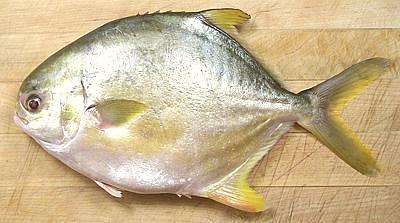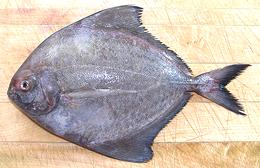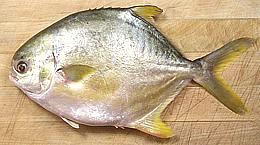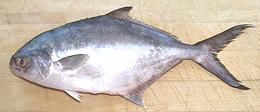 [family Carangidae (Jacks & Pompanos)]
[family Carangidae (Jacks & Pompanos)]
These are fairly deep bodied ocean fish of family Carangidae (Jacks and Pompanos). and are prized eating fish worldwide. The family is, however, a bit confusing because some pompanos are called Butterfish and Pomfret while some fish from those families are called "Pompano".
More on Varieties of Fish
(very large page).
 [C. Parastromateus niger]
[C. Parastromateus niger]
Actually not a Pomfret but a Pompano (the two families look a lot alike),
this is an Indo-West Pacific fish ranging from the north coast of Australia
to southern Japan and from Africa to Borneo. It can grow to 29
inches but the photo specimen was 10-1/2 inches and weighed just over
15 ounces, toward the large size seen in the markets. Black pomfret vary
in darkness - the photo specimen is darker than many. Though highly
commercial this is a fast breeding fish and not considered threatened.
Details and Cooking.
 [Trachinotus carolinus (Florida Pompano, Common Pompano);
Trachinotus blochii (Golden Pompano, Asian Pompano)]
[Trachinotus carolinus (Florida Pompano, Common Pompano);
Trachinotus blochii (Golden Pompano, Asian Pompano)]
These Pompano are highly preferred eating fish. The specimen in the
photo was marketed as "Golden Pompano" which is supposed to be
T. blochii but it looks more like Florida Pompano
T. carolinus. T. blochii has a much longer dorsal fin. Both
can vary in shape because they tend to get more elongated as they become
older and larger. Florida wild caught pompanos are very expensive
(actually this fish is found from Massachusetts to Brazil). Both species
are farmed commercially and I wouldn't be at all surprised at hybrids of
the two. T. carolinus can grow to 25 inches and T. blochii
to 43 inches, but the photo specimen was 12-1/4 inches and weighed 1
pound 9 ounces, at the high end of market size here in Los Angeles.
Details and Cooking.
 [Trachinotus paitensis]
[Trachinotus paitensis]
The Paloma Pomapno is a highly desirable eating fish, but not well known
due to its limited range, and that it is not currently farmed. It is
found close to the coast from Southern California to Peru, and around
the Galapagos Islands. It is a minor commercial catch through this range.
All three of the specimens I purchased had a slight golden
blush along the lower flank, typical of the species, but not visible
in the photo.This fish can grow to 20 inches, but are commonly 12
inches. The photo specimen was 14 inches and weighed 15-1/4 ounces.
Details and Cooking.
 [Old Wife, Banner Pompano, Palometa, Cobbler, Gafftopsail (Caribbean);
Trachinotus goodei]
[Old Wife, Banner Pompano, Palometa, Cobbler, Gafftopsail (Caribbean);
Trachinotus goodei]
This fish is native to the West Atlantic coast from Massachusetts to Argentina, including Bermuda, the Caribbean Islands, and Gulf of Mexico. It can grow to 19-1/2 inches and 1-1/4 pounds, but is commonly 14 inches. It is primarily a game fish. IUCN Red List LC (Least Concern). Details and Cooking. Photo by Brian Gratwicke distributed under license Creative Commons Attribution 2.0 Generic.